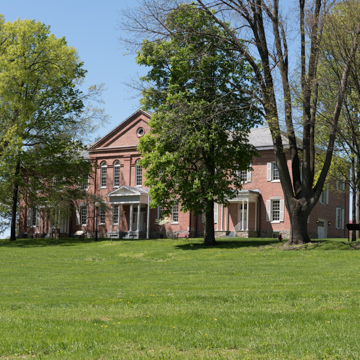You are here
Conrad Wirth Hall (Anthony Memorial Hall)
The south wing of this tripartite structure was built as the armory superintendent's quarters. A two-story, hip-roofed brick building, it is typical of Superintendent Symington's work. A north service wing was demolished in 1881 when construction was begun on Anthony Hall, and the former house then became a wing of the new building. Its hipped roof was extended to the side wall of the large, pedimented central block of the hall, and a north wing was built to match it. The central block is handsomely articulated with brick pilasters supporting a pedimented gable. The elongated second-story windows have round arches, and the pediment frames an oculus. The whole ensemble is remarkably unified.
Anthony Memorial Hall, the main building of Storer College, housed the chapel, offices, the library, and classrooms. It was rebuilt after a fire in 1928. In 1964 it became the Stephen J. Mather Interpretive Training and Research Center of the National Park Service. Now renamed Conrad Wirth Hall in honor of a former director of the Park Service, it serves as classrooms and offices, uses remarkably similar to those it served as a college building.
Writing Credits
If SAH Archipedia has been useful to you, please consider supporting it.
SAH Archipedia tells the story of the United States through its buildings, landscapes, and cities. This freely available resource empowers the public with authoritative knowledge that deepens their understanding and appreciation of the built environment. But the Society of Architectural Historians, which created SAH Archipedia with University of Virginia Press, needs your support to maintain the high-caliber research, writing, photography, cartography, editing, design, and programming that make SAH Archipedia a trusted online resource available to all who value the history of place, heritage tourism, and learning.














